check engine Ram ProMaster 2016 Owner's Guide
[x] Cancel search | Manufacturer: RAM, Model Year: 2016, Model line: ProMaster, Model: Ram ProMaster 2016Pages: 448, PDF Size: 3.28 MB
Page 376 of 448

Cooling System Pressure Cap
The cap must be fully tightened to prevent loss of engine
coolant (antifreeze), and to ensure that engine coolant
(antifreeze) will return to the radiator from the coolant
recovery tank.
The cap should be inspected and cleaned if there is any
accumulation of foreign material on the sealing surfaces.
WARNING!
•Do not open hot engine cooling system. Never add
engine coolant (antifreeze) when the engine is
overheated. Do not loosen or remove the cap to cool
an overheated engine. Heat causes pressure to
build up in the cooling system. To prevent scalding
or injury, do not remove the pressure cap while the
system is hot or under pressure.
(Continued)
WARNING! (Continued)
•Do not use a pressure cap other than the one
specified for your vehicle. Personal injury or en-
gine damage may result.
Disposal Of Used Engine Coolant
Used ethylene glycol-based engine coolant (antifreeze) is
a regulated substance requiring proper disposal. Check
with your local authorities to determine the disposal
rules for your community. To prevent ingestion by ani-
mals or children, do not store ethylene glycol-based
engine coolant in open containers or allow it to remain in
puddles on the ground. If ingested by a child or pet, seek
emergency assistance immediately. Clean up any ground
spills immediately.
374 MAINTAINING YOUR VEHICLE
Page 377 of 448

Coolant Level
The coolant expansion bottle provides a quick visual
method for determining that the coolant level is ad-
equate. With engine off and cold, the level of the engine
coolant (antifreeze) in the bottle should be between the
“MIN” and “MAX” marks.
Points To Remember
NOTE:When the vehicle is stopped after a few miles/
kilometers of operation, you may observe vapor coming
from the front of the engine compartment. This is nor-
mally a result of moisture from rain, snow, or high
humidity accumulating on the radiator and being vapor-
ized when the thermostat opens, allowing hot engine
coolant (antifreeze) to enter the radiator.
If an examination of your engine compartment shows no
evidence of radiator or hose leaks, the vehicle may be
safely driven. The vapor will soon dissipate. •
Do not overfill the coolant expansion bottle.
• Check the coolant freeze point in the radiator and in
the coolant expansion bottle. If engine coolant (anti-
freeze) needs to be added, the contents of the coolant
expansion bottle must also be protected against freez-
ing.
• If frequent engine coolant (antifreeze) additions are
required, the cooling system should be pressure tested
for leaks.
• Maintain engine coolant (antifreeze) concentration at a
minimum of 50% OAT coolant (conforming to
MS.90032) and distilled water for proper corrosion
protection of your engine which contains aluminum
components.
• Make sure that the coolant expansion bottle overflow
hoses are not kinked or obstructed.
7
MAINTAINING YOUR VEHICLE 375
Page 378 of 448

•Keep the front of the radiator clean. If your vehicle is
equipped with air conditioning, keep the front of the
condenser clean.
• Do not change the thermostat for Summer or Winter
operation. If replacement is ever necessary, install
ONLY the correct type thermostat. Other designs may
result in unsatisfactory engine coolant (antifreeze)
performance, poor gas mileage, and increased emis-
sions.
Brake System
In order to assure brake system performance, all brake
system components should be inspected periodically.
Refer to the “Maintenance Schedule” for the proper
maintenance intervals.
WARNING!
Riding the brakes can lead to brake failure and
possibly a collision. Driving with your foot resting or
riding on the brake pedal can result in abnormally
high brake temperatures, excessive lining wear, and
possible brake damage. You would not have your full
braking capacity in an emergency.
Master Cylinder — Brake Fluid Level Check
The fluid level in the master cylinder should be checked
when performing underhood services, or immediately if
the “Brake System Warning Light” indicates system
failure.
Clean the top of the master cylinder area before removing
the cap. Add fluid to bring the level up to the top of the
“FULL” mark on the side of the master cylinder reservoir.
376 MAINTAINING YOUR VEHICLE
Page 379 of 448
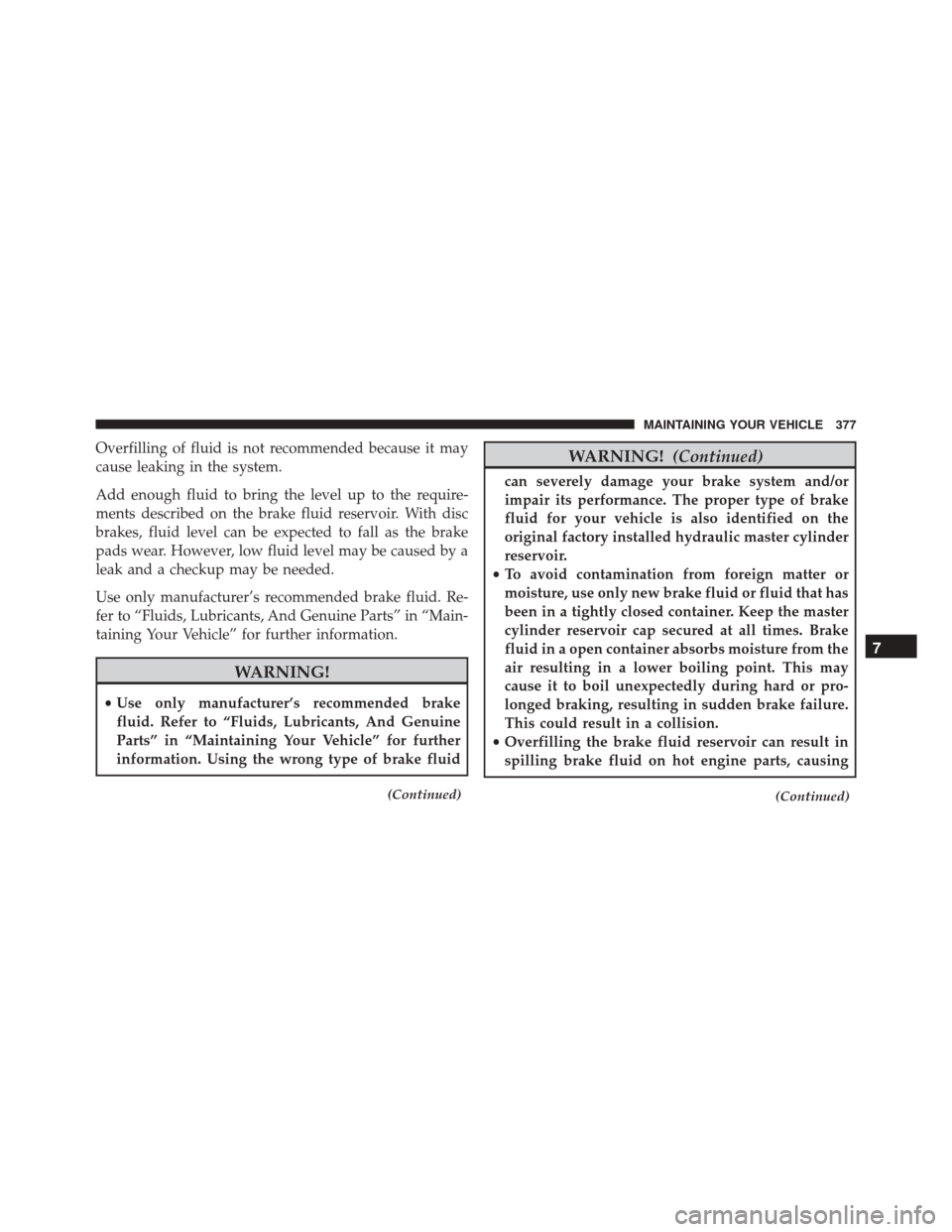
Overfilling of fluid is not recommended because it may
cause leaking in the system.
Add enough fluid to bring the level up to the require-
ments described on the brake fluid reservoir. With disc
brakes, fluid level can be expected to fall as the brake
pads wear. However, low fluid level may be caused by a
leak and a checkup may be needed.
Use only manufacturer’s recommended brake fluid. Re-
fer to “Fluids, Lubricants, And Genuine Parts” in “Main-
taining Your Vehicle” for further information.
WARNING!
•Use only manufacturer’s recommended brake
fluid. Refer to “Fluids, Lubricants, And Genuine
Parts” in “Maintaining Your Vehicle” for further
information. Using the wrong type of brake fluid
(Continued)
WARNING! (Continued)
can severely damage your brake system and/or
impair its performance. The proper type of brake
fluid for your vehicle is also identified on the
original factory installed hydraulic master cylinder
reservoir.
• To avoid contamination from foreign matter or
moisture, use only new brake fluid or fluid that has
been in a tightly closed container. Keep the master
cylinder reservoir cap secured at all times. Brake
fluid in a open container absorbs moisture from the
air resulting in a lower boiling point. This may
cause it to boil unexpectedly during hard or pro-
longed braking, resulting in sudden brake failure.
This could result in a collision.
• Overfilling the brake fluid reservoir can result in
spilling brake fluid on hot engine parts, causing
(Continued)
7
MAINTAINING YOUR VEHICLE 377
Page 381 of 448
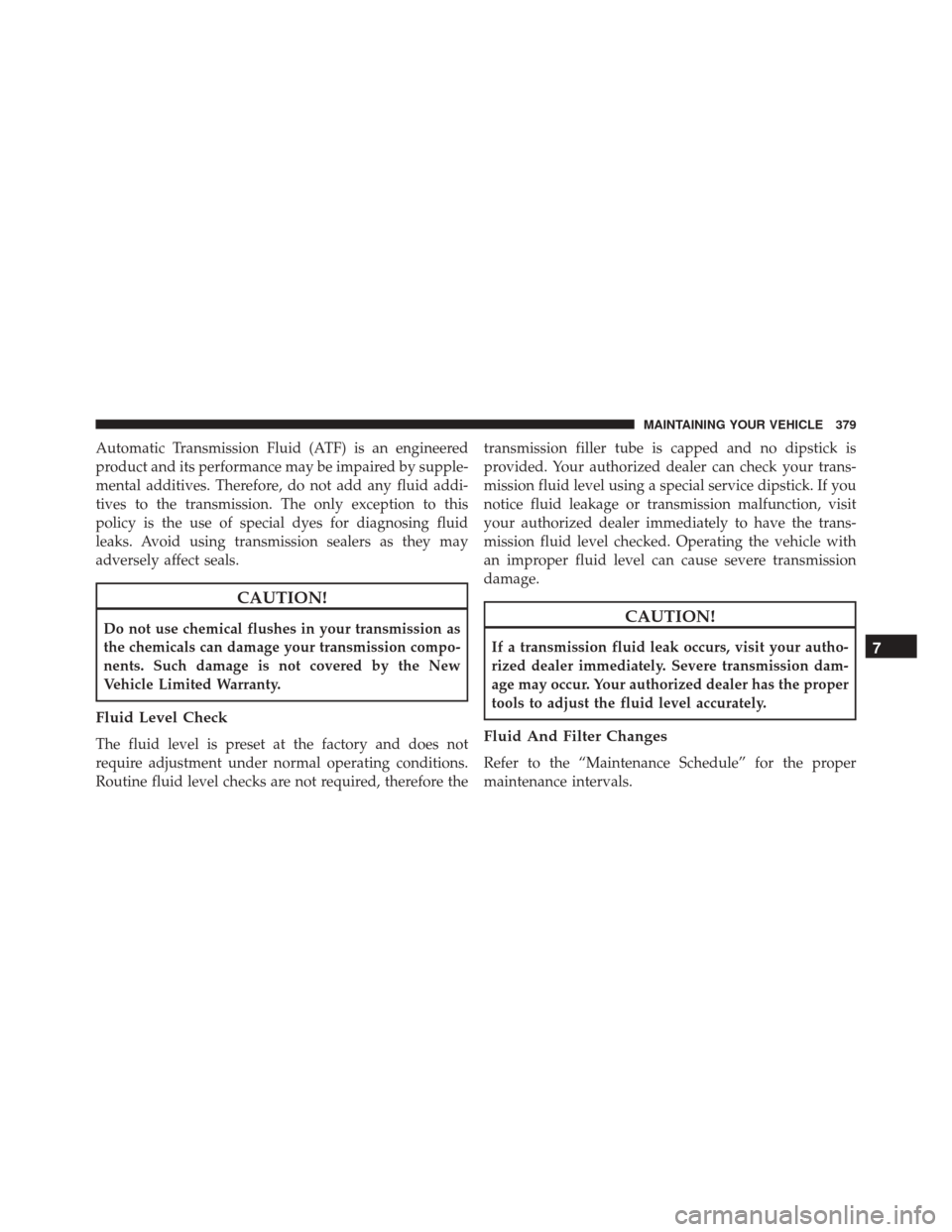
Automatic Transmission Fluid (ATF) is an engineered
product and its performance may be impaired by supple-
mental additives. Therefore, do not add any fluid addi-
tives to the transmission. The only exception to this
policy is the use of special dyes for diagnosing fluid
leaks. Avoid using transmission sealers as they may
adversely affect seals.
CAUTION!
Do not use chemical flushes in your transmission as
the chemicals can damage your transmission compo-
nents. Such damage is not covered by the New
Vehicle Limited Warranty.
Fluid Level Check
The fluid level is preset at the factory and does not
require adjustment under normal operating conditions.
Routine fluid level checks are not required, therefore thetransmission filler tube is capped and no dipstick is
provided. Your authorized dealer can check your trans-
mission fluid level using a special service dipstick. If you
notice fluid leakage or transmission malfunction, visit
your authorized dealer immediately to have the trans-
mission fluid level checked. Operating the vehicle with
an improper fluid level can cause severe transmission
damage.
CAUTION!
If a transmission fluid leak occurs, visit your autho-
rized dealer immediately. Severe transmission dam-
age may occur. Your authorized dealer has the proper
tools to adjust the fluid level accurately.
Fluid And Filter Changes
Refer to the “Maintenance Schedule” for the proper
maintenance intervals.
7
MAINTAINING YOUR VEHICLE 379
Page 413 of 448
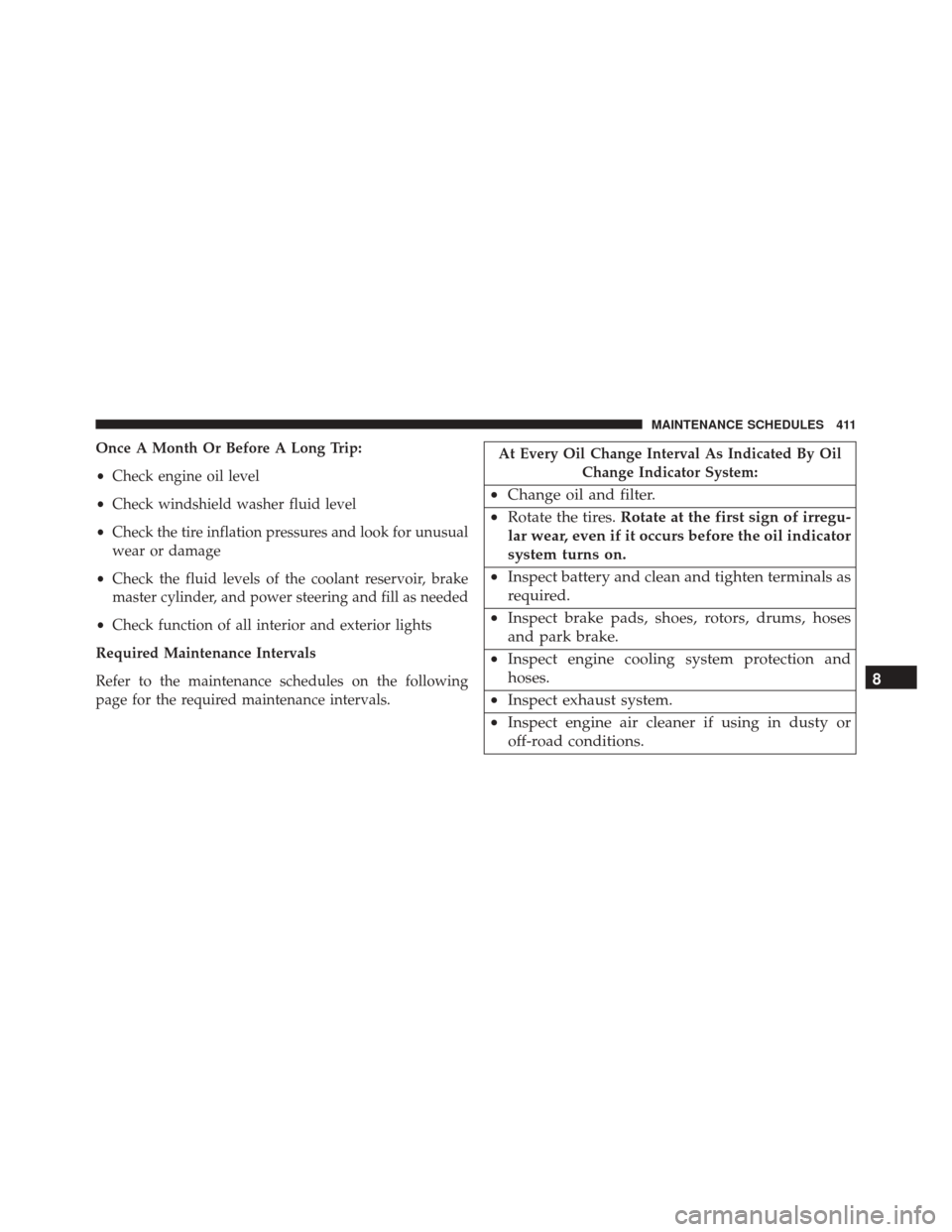
Once A Month Or Before A Long Trip:
•Check engine oil level
• Check windshield washer fluid level
• Check the tire inflation pressures and look for unusual
wear or damage
• Check the fluid levels of the coolant reservoir, brake
master cylinder, and power steering and fill as needed
• Check function of all interior and exterior lights
Required Maintenance Intervals
Refer to the maintenance schedules on the following
page for the required maintenance intervals.At Every Oil Change Interval As Indicated By Oil Change Indicator System:
•Change oil and filter.
• Rotate the tires. Rotate at the first sign of irregu-
lar wear, even if it occurs before the oil indicator
system turns on.
• Inspect battery and clean and tighten terminals as
required.
• Inspect brake pads, shoes, rotors, drums, hoses
and park brake.
• Inspect engine cooling system protection and
hoses.
• Inspect exhaust system.
• Inspect engine air cleaner if using in dusty or
off-road conditions. 8
MAINTENANCE SCHEDULES 411
Page 434 of 448
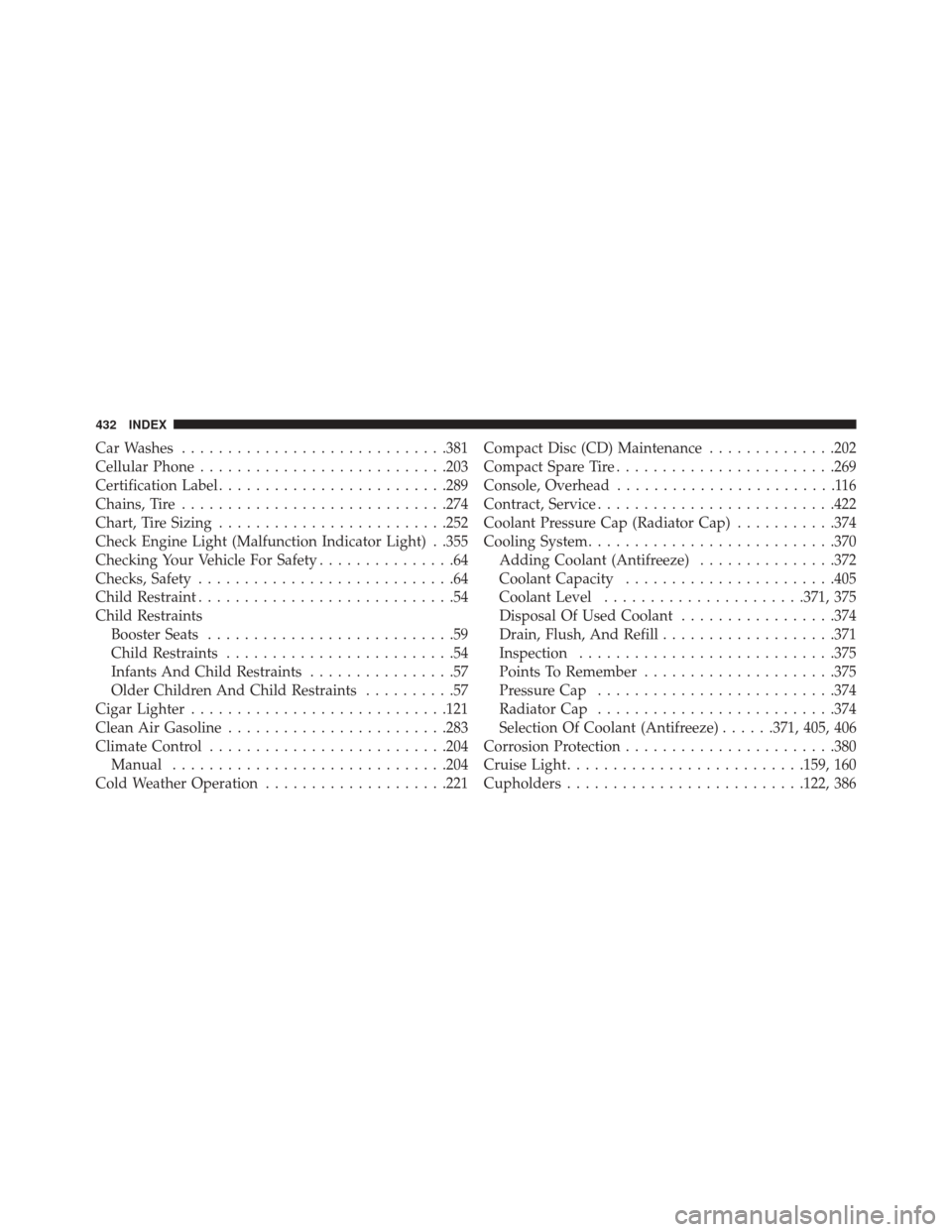
Car Washes............................ .381
Cellular Phone .......................... .203
Certification Label ........................ .289
Chains, Tire ............................ .274
Chart, Tire Sizing ........................ .252
Check Engine Light (Malfunction Indicator Light) . .355
Checking Your Vehicle For Safety ...............64
Checks, Safety ............................64
Child Restraint ............................54
Child Restraints Booster Seats ...........................59
Child Restraints .........................54
Infants And Child Restraints ................57
Older Children And Child Restraints ..........57
Cigar Lighter ........................... .121
Clean Air Gasoline ....................... .283
Climate Control ......................... .204
Manual ............................. .204
Cold Weather Operation ....................221 Compact Disc (CD) Maintenance
..............202
Compact Spare Tire ....................... .269
Console, Overhead ........................116
Contract, Service ......................... .422
Coolant Pressure Cap (Radiator Cap) ...........374
Cooling System .......................... .370
Adding Coolant (Antifreeze) ...............372
Coolant Capacity ...................... .405
Coolant Level ..................... .371, 375
Disposal Of Used Coolant .................374
Drain, Flush, And Refill ...................371
Inspection ........................... .375
Points To Remember .....................375
Pressure Cap ......................... .374
Radiator Cap ......................... .374
Selection Of Coolant (Antifreeze) ......371, 405, 406
Corrosion Protection ...................... .380
Cruise Light ......................... .159, 160
Cupholders ......................... .122, 386
432 INDEX
Page 436 of 448
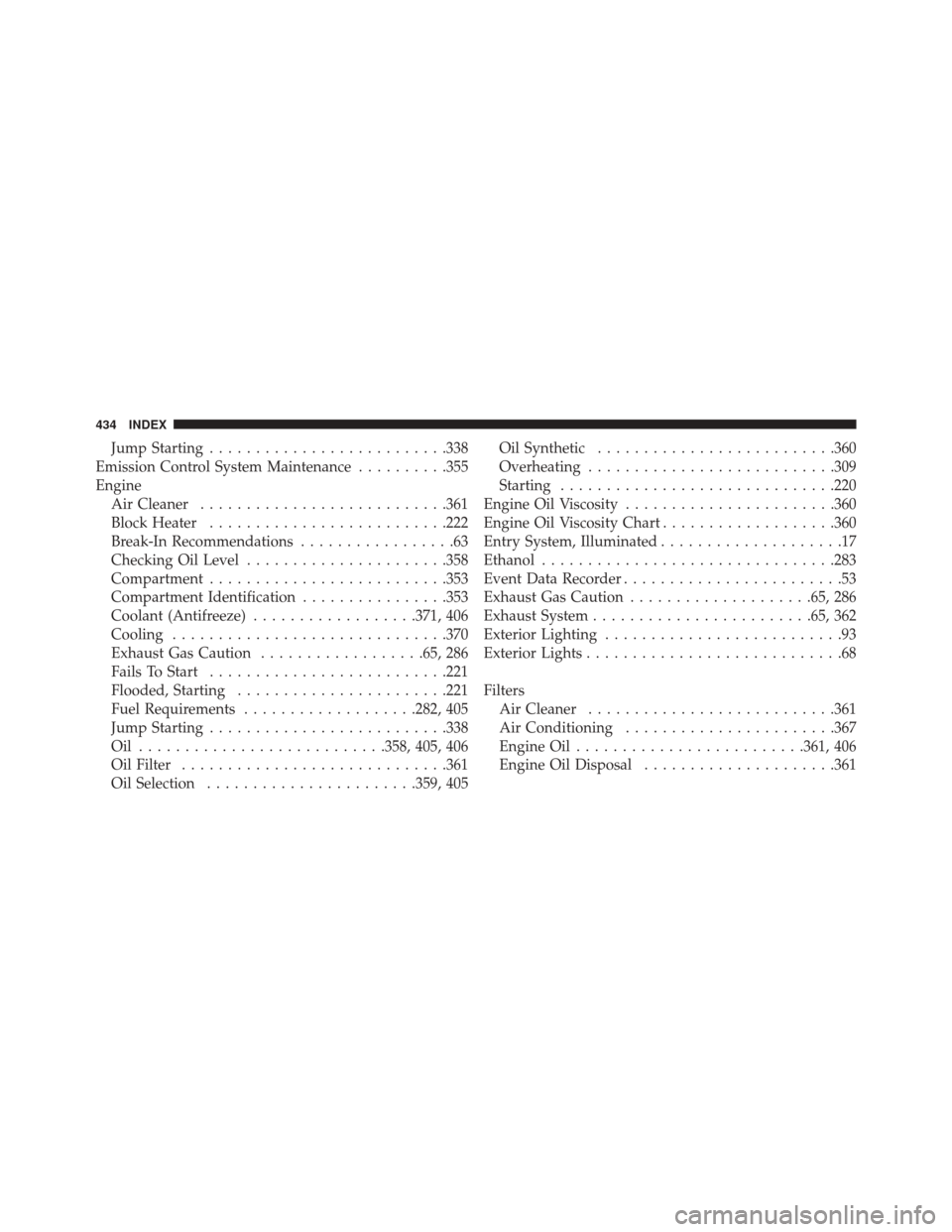
Jump Starting......................... .338
Emission Control System Maintenance ..........355
Engine Air Cleaner .......................... .361
Block Heater ......................... .222
Break-In Recommendations .................63
Checking Oil Level ..................... .358
Compartment ......................... .353
Compartment Identification ................353
Coolant (Antifreeze) ..................371, 406
Cooling ............................. .370
Exhaust Gas Caution ..................65, 286
Fails To Start ......................... .221
Flooded, Starting ...................... .221
Fuel Requirements ...................282, 405
Jump Starting ......................... .338
Oil .......................... .358, 405, 406
Oil Filter ............................ .361
Oil Selection ...................... .359, 405Oil Synthetic
......................... .360
Overheating .......................... .309
Starting ............................. .220
Engine Oil Viscosity ...................... .360
Engine Oil Viscosity Chart ...................360
Entry System, Illuminated ....................17
Ethanol ............................... .283
Event Data Recorder ........................53
Exhaust Gas Caution ....................65, 286
Exhaust System ....................... .65, 362
Exterior Lighting ..........................93
Exterior Lights ............................68
Filters Air Cleaner .......................... .361
Air Conditioning ...................... .367
Engine Oil ........................ .361, 406
Engine Oil Disposal .....................361
434 INDEX
Page 437 of 448

FlashersHazard Warning ....................... .309
Turn Signal ........................ .68, 157
Flooded Engine Starting ....................221
Fluid Capacities ......................... .405
Fluid Leaks ..............................68
Fluid Level Checks Automatic Transmission ..................379
Brake ............................... .376
Cooling System ........................ .371
Power Steering ........................ .238
Fluids, Lubricants And Genuine Parts ...........406
Fog Lights ...............................94
Four-Way Hazard Flasher ...................309
Freeing A Stuck Vehicle .....................344
Fuel .................................. .282
Adding ............................. .287
Additives ............................ .284
Clean Air ............................ .283Ethanol
............................. .283
Filler Cap (Gas Cap) .....................287
Gasoline ............................. .282
Materials Added ....................... .284
Methanol ............................ .283
Octane Rating ..................... .282, 406
Requirements ...................... .282, 405
Tank Capacity ......................... .405
Fueling ............................... .287
Fuses ................................. .387
Gas Cap (Fuel Filler Cap) .............287, 288, 355
Gasoline, Clean Air ....................... .283
Gasoline (Fuel) .......................... .282
Gasoline, Reformulated .....................283
Gear Ranges ............................ .225
Gear Select Lever Override ..................346
General Information ................... .204, 281
Glass
Cleaning .......................... .385
10
INDEX 435
Page 439 of 448
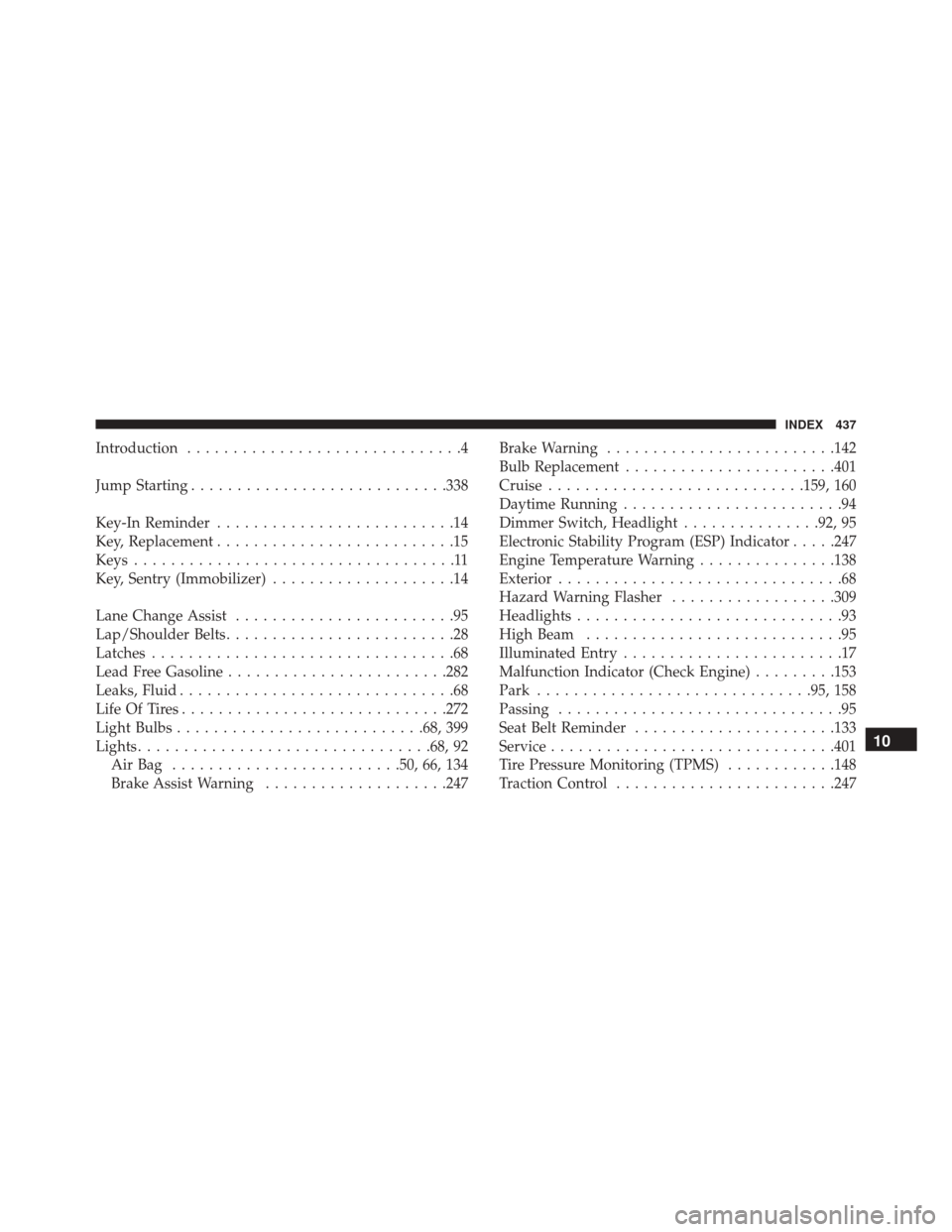
Introduction..............................4
Jump Starting ........................... .338
Key-In Reminder ..........................14
Key, Replacement ..........................15
Keys ...................................11
Key, Sentry (Immobilizer) ....................14
Lane Change Assist ........................95
Lap/Shoulder Belts .........................28
Latches .................................68
Lead Free Gasoline ....................... .282
Leaks, Fluid ..............................68
Life Of Tires ............................ .272
Light Bulbs .......................... .68, 399
Lights ............................... .68, 92
AirBag .........................50, 66, 134
Brake Assist Warning ....................247 Brake Warning
........................ .142
Bulb Replacement ...................... .401
Cruise ........................... .159, 160
Daytime Running ........................94
Dimmer Switch, Headlight ...............92, 95
Electronic Stability Program (ESP) Indicator .....247
Engine Temperature Warning ...............138
Exterior ...............................68
Hazard Warning Flasher ..................309
Headlights .............................93
High Beam ............................95
Illuminated Entry ........................17
Malfunction Indicator (Check Engine) .........153
Park ............................. .95, 158
Passing ...............................95
Seat Belt Reminder ..................... .133
Service .............................. .401
Tire Pressure Monitoring (TPMS) ............148
Traction Control ....................... .247
10
INDEX 437